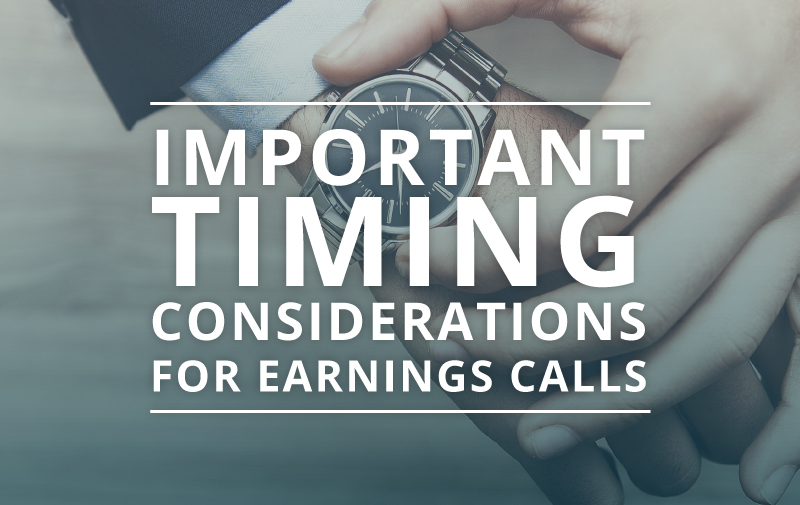Following the end of a quarter, depending on public float and certain exceptions following IPOs, the Securities and Exchange Commission (SEC) requires companies to file quarterly and annual results via the respective 10-Q or 10-K forms. Typically, companies have 35-45 days to report their quarterly results, and year-end results are due within 60-90 days. Companies that host earnings conference calls will schedule them after the quarterly results are fully audited and before the filing deadline. For some companies, that is a big window of time, and for others it’s quite narrow.
So, provided you have some flexibility in selecting a date, how do you know the optimal timing for releasing those results? Is it better to be first out of the gate, or to wait until your peers and competitors have reported? Does timing really make a difference?
In general, larger companies will report quarterly results first, followed by mid-cap companies, and the smallest companies will report towards the end of the earnings cycle. This is largely due to timing of audit completion. Regardless of where you fall in terms of market cap size, consider these factors when determining a reporting date that works best for your company:
The sooner you report, the quicker you can have a more open dialogue in investor meetings. This opens the window to a longer investor marketing cycle. That said, a few weeks of additional time might provide important information about current quarterly trends, which could impact annual guidance and/or commentary about short term expectations. For large, diversified companies who provide high-level annual guidance, a few weeks will not likely shape the overall outlook given the many variables and inputs factored into guidance. But, for smaller companies that tend to have more concentrated businesses and volatility, a few weeks could provide valuable insight.
Ending your quiet period as soon as possible enables you to begin responding to inquiries and eliminates any potential speculation on your performance that may stem from competitors’ comments. On the other hand, following a competitor provides the advantage of listening to their prepared remarks – particularly regarding industry dynamics such as utilization, reimbursement, pricing trends, and competition – as well as listening to questions from analysts. With this, you can be better prepared to anticipate and address questions or potential concerns from Wall Street.
There is sometimes the perception that the longer a company waits to report its results, the worse those results will be and/or the less organized the finance department is. This really only rears its head when a company normally reports results within a certain timeframe, and on any given quarter there is a relative delay. Data aggregators and the Street track “normal” report dates for most companies and expectations are set based on historical reporting dates. With this in mind, some companies choose to report on the same day each quarter (i.e. the third Tuesday following quarter-end) to establish predictability; others choose to report on a slightly different day each quarter to avoid this potential issue. We typically advise our clients to report within a general timeframe but not to be so consistent as to raise a flag if the date varies by a few days.
Finally, consider the conference calendar in certain quarters. Key industry tradeshows and investor conferences often fall within earnings windows. If you plan to participate in an investor conference after your quarter has closed, we strongly recommend you try to report results beforehand to enable productive conversations. If this isn’t possible, then each conversation needs to be prefaced with the date of your last public update and commentary that makes it clear you aren’t providing an update on the quarter.
Regardless of when you decide to report quarterly earnings, we believe it’s often worth checking with a few of your key analysts to ensure you aren’t overlapping with a competitor or industry event such as a large cap analyst meeting. While all companies issue advisory press releases with the details of their call, the timing of those releases can vary. This can make it difficult to get a full picture of how crowded a certain date or time may be.
If you can’t avoid going out on a crowded day, consider moving the timing of your call up or back by 30 minutes. If that’s not an option, send a PDF of your script to covering analysts immediately after the call so they can begin preparing a note before an official transcript is available. This will ensure the analyst gets the facts correct and in a timely manner.
Conclusion
We can help you establish best practices surrounding your communications efforts with your investors. Putting simple guidelines in place ensures your message is getting across accurately in a timely manner, and ultimately, fosters a stronger relationship with the investment community. Managing expectations surrounding earnings season is key to building trust, and we would love to partner with you to maximize the benefits of this process.
Leigh Salvo, Managing Director


Leave a Reply